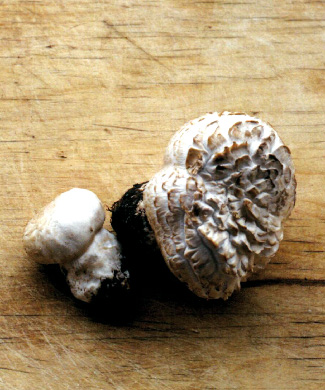Tabular mushroom: Red Data Book of Armenia

Category. EN – Endangered.
Brief description. Cap is from 5 to 25 cm across, white, white greyish, when touched turns yellow. It is thick and fleshy, hemispheric, then spread, sometimes flat in the centre covered with pyramidal or tabular squama. Edges are plicated or smooth and are often with partial remnants of the volva. Flesh is white, pink when cut with pleasant mushroom taste and odour. Gills are narrow, at first pink eventually turn dark brown, almost black. Stipe is from 4–5 x 1–3 cm long, white, whitish, central, velvety or glabrous with simple broad, whitish ring. Spore print is dark brown. Spores are 6,5–9 x 5,5–7 µm brown, large ovoid.
Distribution. Generally in North America, Europe, Southern Caucasus (Armenia, Georgia). It is rare in a number of European countries. In Armenia it is found in Aragats floristic region – in the riverside of the river Arkhashan; Sevan floristic region – in the surroundings of Sevan, in pastures.
Ecological, biological and phytocenological peculiarities. It can be found on the soil, in the upper mountain belt – in the alpine meadows, in pastures on the altitude of 2500–3500 m above sea level in June and July. Saprotrophic fungi on humus. Fruit bodies are edible.
Main factors of endangering. Limited distribution, degradation and breakdown of ecosystems, expand of pastures.
Nature conservation measures. In Armenia it is conserved in corresponding ecosystems of "Sevan" National Park. It is necessary to take measures for monitoring the state of the discovered populations and for discovering new cultivation places as well.
Suggestions
 The Ministry of Environment sent a letter international partners to draw their attention to the real danger of environmental disasters as a result of Azerbaijan's large-scale aggression towards the territory of Armenia
The Ministry of Environment sent a letter international partners to draw their attention to the real danger of environmental disasters as a result of Azerbaijan's large-scale aggression towards the territory of Armenia
 Vicia pisiformis: Red Data Book of Armenia
Vicia pisiformis: Red Data Book of Armenia
 Vavilovia formosa: Red Data Book of Armenia
Vavilovia formosa: Red Data Book of Armenia
 Trigonella capitata: Red Data Book of Armenia
Trigonella capitata: Red Data Book of Armenia
 Trigonella astroides: Red Data Book of Armenia
Trigonella astroides: Red Data Book of Armenia












